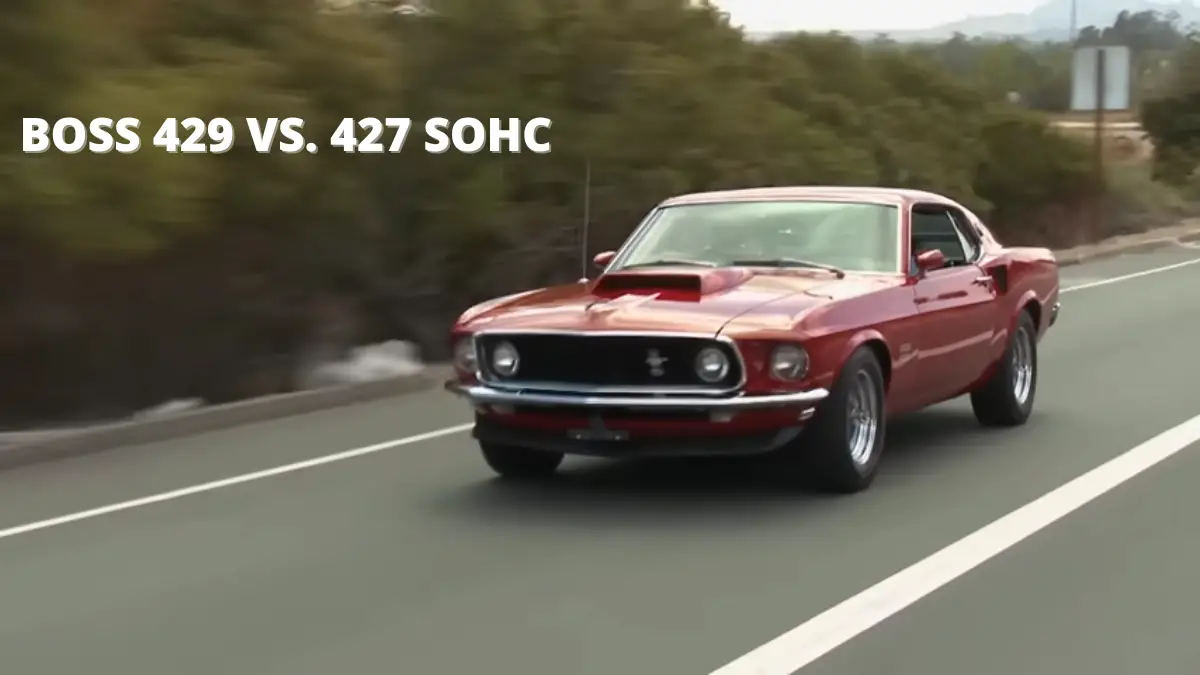In this article, we’ll get deep into the history, specifications, and performance of Boss 429 and 427 SOHC iconic engines to determine which one reigns supreme.
The Boss 429: A NASCAR Legend
Origins and Development
The Boss 429 was developed by Ford in the late 1960s, primarily for use in the NASCAR racing circuit. The engine was a response to the dominating performance of the Chrysler Hemi engines in NASCAR races. Ford aimed to create an engine that could outperform the competition and secure them the championship.
Engine Specifications
The Boss 429 is a V8 engine with a 7.0-liter displacement and hemispherical combustion chambers. It features a forged steel crankshaft, aluminum heads, and an impressive 375 horsepower at 5,200 RPM. With a torque output of 450 lb-ft at 3,400 RPM, this engine packs a serious punch.
The 427 SOHC: Ford’s Answer to the Hemi
A Storied History
The 427 SOHC, also known as the “Cammer,” was Ford’s answer to the Chrysler Hemi engine. It was designed in the mid-1960s and was intended for use in the NASCAR racing series. However, NASCAR ultimately banned the engine due to its perceived unfair advantage, and it never saw official competition. Instead, the 427 SOHC became a popular choice for drag racers and hot rodders.
Power and Performance
The 427 SOHC is a 7.0-liter V8 engine that utilizes a single overhead camshaft (SOHC) design. The engine boasts an impressive 616 horsepower at 7,000 RPM and 515 lb-ft of torque at 3,800 RPM, making it a formidable competitor in the muscle car engine landscape.
Head-to-Head: Comparing the Boss 429 and 427 SOHC
Power Output
On paper, the 427 SOHC has a clear advantage in terms of power output, with a whopping 616 horsepower compared to the Boss 429’s 375 horsepower. However, it’s worth noting that these numbers can vary depending on tuning and modifications.
Streetability
When it comes to everyday driving, the Boss 429 has a more manageable powerband and is generally considered easier to drive on the street. The 427 SOHC, with its higher horsepower and more aggressive cam profile, can be more challenging for street driving.
Rarity and Collectability
Both engines are highly sought after by collectors, but the Boss 429 is generally considered more rare and valuable. Only around 1,350 Boss 429 engines were produced, while the 427 SOHC was sold over the counter as a crate engine, making its production numbers somewhat more difficult to pin down.
Conclusion
The Boss 429, with its rich NASCAR history and street-friendly powerband, may be the better choice for those seeking a more manageable driving experience.
On the other hand, the 427 SOHC, with its impressive power output and drag racing pedigree, could be the ultimate choice for those chasing maximum performance.
FAQs
- Why was the 427 SOHC banned from NASCAR? The 427 SOHC was banned from NASCAR because it was considered to have an unfair advantage over other engines due to its high power output and advanced design. NASCAR officials felt that allowing the 427 SOHC to compete would disrupt the competitive balance of the series.
- Can I still find a Boss 429 or 427 SOHC engine today? Yes, both Boss 429 and 427 SOHC engines can still be found today, but they are highly sought after and can be quite expensive. You may come across them at classic car auctions, specialty dealers, or even private sales. Be prepared to invest a significant amount of money if you want to acquire one of these legendary engines.
- How do the Boss 429 and 427 SOHC engines perform in modern cars? While these engines were designed in the 1960s, they can still provide impressive performance in modern cars with the proper modifications and tuning. However, keep in mind that modern engines have made significant advancements in technology, fuel efficiency, and emissions standards, so a direct comparison may not be entirely fair.
- Are there modern engines that can rival the performance of the Boss 429 and 427 SOHC?Yes, there are several modern engines that can rival or even surpass the performance of these classic muscle car engines. For example, the Ford Shelby GT500’s 5.2-liter supercharged V8 engine produces over 700 horsepower, while the Chevrolet Corvette ZR1’s 6.2-liter supercharged V8 outputs 755 horsepower. These engines benefit from decades of advancements in technology, materials, and engineering.
- What cars were the Boss 429 and 427 SOHC engines originally found in? The Boss 429 engine was primarily installed in the 1969 and 1970 Ford Mustang Boss 429, while the 427 SOHC was intended for use in NASCAR racing vehicles. However, due to the ban, it never saw official competition and instead found its way into various custom-built drag racers and hot rods.


